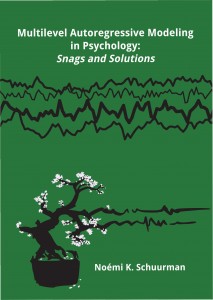Methods & Statistics
Social Sciences
Utrecht University
Supervisors
Prof. Herbert Hoijtink & Dr Ellen Hamaker
On June 27th 2016, Noémi Schuurman defended her thesis entitled
Multilevel Autoregressive Modeling in Psychology: Snags and Solutions
 Summary
Summary
Psychological processes are of interest in all areas of psychology, and all such processes occur within individuals over time. Some examples of psychological processes are the regulation of daily mood, the effect of job motivation on job performance and vice versa, or social interactions between a parent and child. In order to study these processes it is necessary to take many repeated measures for each individual. Multilevel autoregressive models are statistical models than can be used to analyze this kind of data – data that consist of many repeated measures, for many individuals.
The approach of autoregressive models is summarized well with the saying “The best predictor of future behavior is past behavior”: In autoregressive models, current observations are used to predict future observations. By extending the autoregressive model to a multilevel autoregressive model, it becomes possible to model the repeated measures for many individuals at the same time, while also modeling the differences between the processes of each individual.
Multilevel autoregressive models are increasing in popularity within psychology, however, the methods for analyzing psychological data with these models are still being developed. The aim for this dissertation was to further investigate, explicate, and if possible remedy certain difficulties in fitting and interpreting multilevel autoregressive models in the context of psychological science. Specifically, in Chapter 1 it is discussed why it is important to collect many repeated measures for studying psychological processes, and why it is important to model these processes on an individual level, as well as the similarities and differences between the individuals’ processes. In Chapter 2 a difficulty with specifying an Inverse-Wishart prior distribution for the covariance matrix of the random parameters is explored, in the context of fitting the multilevel autoregressive model in a Bayesian framework. In Chapter 3 it is discussed how to standardize the model parameters, such that we can make meaningful comparisons of the strength of the cross-lagged effects in a multivariate model. In Chapters 4 and 5 the consequences of ignoring measurement errors for the estimation of the model parameters are investigated for respectively a single-subject autoregressive model and the multilevel autoregressive model, as well as how to account for measurement errors in these models. The final chapter of this dissertation contains a summary of the work presented in the previous chapters, and a discussion of some limitations of the multilevel autoregressive modeling approach.
Project
Time for a change; Studying individual differences in dynamics with multilevel multivariate autoregressive models.
There is growing interest among psychological researchers to study processes unfolding over time, as opposed to merely focusing on the static outcomes of these processes. This paradigm shift is accompanied by an increased need for longitudinal models that capture the essence of processes, and allow for individual differences therein. While the study of developmental processes has blossomed with the introduction of latent growth curve models, statistical techniques for studying stationary (i.e., stable) processes are seriously lagging behind the needs of applied researchers. Stationary processes are characterized by within-person reversible variability over time in the absence of a gross underlying trend. Examples include the daily fluctuations in affect or the interaction between dyadic partners during a conversation. A general modeling strategy for such processes is based on a dynamic systems approach and consists of relating the observations to states (i.e., latent variables), and modeling the dynamics of the process through relating the states over time. From a substantive perspective, estimating random effects in the dynamics is of utmost interest, because they reflect individual differences in important phenomena such as regulatory mechanisms, coping strategies, or psychophysiological interactions. However, at present there are very few techniques available for modeling such individual differences, and those that exist are limited in scope. The current proposal seeks to fill this void by focusing on the development of new longitudinal random effects models for stationary processes. To guarantee these innovations will meet the needs of applied researchers, the current proposal evolves around two substantive topics: 1) the traitstate distinction, and 2) dyadic interaction. Moreover, through collaboration with applied researchers who have collected unique longitudinal datasets, the full potential of these new models will be explored. N. Schuurman’s project is on topic 1: modeling traits and states. This project will focus on using multilevel multivariate autoregressive models for modeling dynamics in psychology.
Financed by
NWO VIDI Ellen Hamaker
